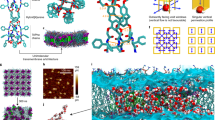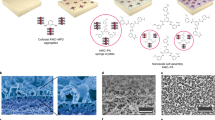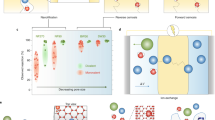Abstract
The outstanding capacity of aquaporins (AQPs) for mediating highly selective superfast water transport1,2,3,4,5,6,7 has inspired recent development of supramolecular monovalent ion-excluding artificial water channels (AWCs). AWC-based bioinspired membranes are proposed for desalination, water purification and other separation applications8,9,10,11,12,13,14,15,16,17,18. While some recent progress has been made in synthesizing AWCs that approach the water permeability and ion selectivity of AQPs, a hallmark feature of AQPs—high water transport while excluding protons—has not been reproduced. We report a class of biomimetic, helically folded pore-forming polymeric foldamers that can serve as long-sought-after highly selective ultrafast water-conducting channels with performance exceeding those of AQPs (1.1 × 1010 water molecules per second for AQP1), with high water-over-monovalent-ion transport selectivity (~108 water molecules over Cl– ion) conferred by the modularly tunable hydrophobicity of the interior pore surface. The best-performing AWC reported here delivers water transport at an exceptionally high rate, namely, 2.5 times that of AQP1, while concurrently rejecting salts (NaCl and KCl) and even protons.
This is a preview of subscription content, access via your institution
Access options
Access Nature and 54 other Nature Portfolio journals
Get Nature+, our best-value online-access subscription
$29.99 / 30 days
cancel any time
Subscribe to this journal
Receive 12 print issues and online access
$259.00 per year
only $21.58 per issue
Buy this article
- Purchase on Springer Link
- Instant access to full article PDF
Prices may be subject to local taxes which are calculated during checkout



Similar content being viewed by others
Data availability
The datasets that support the finding of this study are available in figshare repository with the identifier(s) https://figshare.com/s/0354959049b2c0ed4c61. Source data are provided with this paper.
References
Murata, K. et al. Structural determinants of water permeation through aquaporin-1. Nature 407, 599–605 (2000).
Tajkhorshid, E. et al. Control of the selectivity of the aquaporin water channel family by global orientational tuning. Science 296, 525–530 (2002).
Takata, K., Matsuzaki, T. & Tajika, Y. Aquaporins: water channel proteins of the cell membrane. Prog. Histochem. Cytochem. 39, 1–83 (2004).
de Groot, B. L. & Grubmuller, H. Water permeation across biological membranes: mechanism and dynamics of aquaporin-1 and GlpF. Science 294, 2353–2357 (2001).
Agre, P. Aquaporin water channels (Nobel lecture). Angew. Chem. Int. Ed. 43, 4278–4290 (2004).
Borgnia, M. J., Kozono, D., Calamita, G., Maloney, P. C. & Agre, P. Functional reconstitution and characterization of AqpZ, the E. coli water channel protein. J. Mol. Biol. 291, 1169–1179 (1999).
Horner, A. et al. The mobility of single-file water molecules is governed by the number of H-bonds they may form with channel-lining residues. Sci. Adv. 1, e1400083 (2015).
Fane, A. G., Wang, R. & Hu, M. X. Synthetic membranes for water purification: status and future. Angew. Chem. Int. Ed. 54, 3368–3386 (2015).
Werber, J. R., Osuji, C. O. & Elimelech, M. Materials for next-generation desalination and water purification membranes. Nat. Rev. Mater. 1, 16018 (2016). https://doi.org/10.1038/natrevmats.2016.18
Park, H. B., Kamcev, J., Robeson, L. M., Elimelech, M. & Freeman, B. D. Maximizing the right stuff: the trade-off between membrane permeability and selectivity. Science 356, eaab0530 (2017).
Hélix-Nielsen, C. Biomimetic membranes as a technology platform: challenges and opportunities. Membranes 8, 44–59 (2018).
Werber, J. R. & Elimelech, M. Permselectivity limits of biomimetic desalination membranes. Sci. Adv. 4, eaar8266 (2018).
Freger, V. Selectivity and polarization in water channel membranes: lessons learned from polymeric membranes and CNTs. Faraday Discuss. 209, 371–388 (2018).
Wagh, P. & Escobar, I. C. Biomimetic and bioinspired membranes for water purification: a critical review and future directions. Environ. Prog. Sustainable Energy 38, e13215 (2019).
Barboiu, M. & Gilles, A. From natural to bioassisted and biomimetic artificial water channel systems. Acc. Chem. Res. 46, 2814–2823 (2013).
Huo, Y. P. & Zeng, H. Q. ‘Sticky’-ends-guided creation of functional hollow nanopores for guest encapsulation and water transport. Acc. Chem. Res. 49, 922–930 (2016).
Gong, B. Artificial water channels: inspiration, progress, and challenges. Faraday Discuss. 209, 415–427 (2018).
Song, W. & Kumar, M. Artificial water channels: toward and beyond desalination. Curr. Opin. Chem. Eng. 25, 9–17 (2019).
Bhushan, B. Biomimetics: lessons from nature–an overview. Phil. Trans. R. Soc. A 367, 1445–1486 (2009).
Doyle, D. A. et al. The structure of the potassium channel: molecular basis of K+ conduction and selectivity. Science 280, 69–77 (1998).
Yu, F. H. & Catterall, W. A. Overview of the voltage-gated sodium channel family. Genome Biol. 4, 207 (2003).
Reuter, H. Membranes: a variety of calcium channels. Nature 316, 391 (1985).
Dutzler, R., Campbell, E. B. & MacKinnon, R. Gating the selectivity filter in ClC chloride channels. Science 300, 108–112 (2003).
Mould, J. A. et al. Mechanism for proton conduction of the M2 ion channel of influenza A virus. J. Biol. Chem. 275, 8592–8599 (2000).
Kaucher, M. S. et al. Selective transport of water mediated by porous dendritic dipeptides. J. Am. Chem. Soc. 129, 11698–11699 (2007).
Zhou, X. B. et al. Self-assembling subnanometer pores with unusual mass-transport properties. Nat. Commun. 3, 949 (2012).
Hu, C. B., Chen, Z. X., Tang, G. F., Hou, J. L. & Li, Z. T. Single-molecular artificial transmembrane water channels. J. Am. Chem. Soc. 134, 8384–8387 (2012).
Licsandru, E. et al. Salt-excluding artificial water channels exhibiting enhanced dipolar water and proton translocation. J. Am. Chem. Soc. 138, 5403–5409 (2016).
Zhao, H. Q., Sheng, S., Hong, Y. H. & Zeng, H. Q. Proton gradient-induced water transport mediated by water wires inside narrow aquapores of aquafoldamer molecules. J. Am. Chem. Soc. 136, 14270–14276 (2014).
Shen, Y.-X. et al. Highly permeable artificial water channels that can self-assemble into two-dimensional arrays. Proc. Natl Acad. Sci. USA 112, 9810–9815 (2015).
Song, W. et al. Artificial water channels enable fast and selective water permeation through water-wire networks. Nat. Nanotechnol. 15, 73–79 (2020).
Shen, J. et al. Polypyridine-based helical amide foldamer channels: rapid transport of water and protons with high ion rejection. Angew. Chem. Int. Ed. 59, 13328–13334 (2020).
Shen, J. et al. Aquafoldmer-based aquaporin-like synthetic water channel. J. Am. Chem. Soc. 142, 10050–10058 (2020).
Tunuguntla, R. H. et al. Enhanced water permeability and tunable ion selectivity in subnanometer carbon nanotube porins. Science 357, 792–796 (2017).
Gale, P. A., Davis, J. T. & Quesada, R. Anion transport and supramolecular medicinal chemistry. Chem. Soc. Rev. 46, 2497–2519 (2017).
Sakai, N. & Matile, S. Synthetic ion channels. Langmuir 29, 9031–9040 (2013).
Si, W., Xin, P., Li, Z.-T. & Hou, J.-L. Tubular unimolecular transmembrane channels: construction strategy and transport activities. Acc. Chem. Res. 48, 1612–1619 (2015).
Howorka, S. Building membrane nanopores. Nat. Nanotechnol. 12, 619–630 (2017).
Zheng, S.-P., Huang, L.-B., Sun, Z. & Barboiu, M. Self-assembled artificial ion-channels toward natural selection of functions. Angew. Chem. Int. Ed. 60, https://doi.org/10.1002/anie.201915287 566–597 (2020).
Roy, A. et al. Polyhydrazide-based organic nanotubes as efficient and selective artificial iodide channels. Angew. Chem. Int. Ed. 59, 4806–4813 (2020).
Tunuguntla, R. H., Allen, F. I., Kim, K., Belliveau, A. & Noy, A. Ultrafast proton transport in sub-1-nm diameter carbon nanotube porins. Nat. Nanotechnol. 11, 639–644 (2016).
Ren, C. et al. Molecular swings as highly active ion transporters. Angew. Chem. Int. Ed. 58, 8034–8038 (2019).
Zeng, L. Z., Zhang, H., Wang, T. & Li, T. Enhancing K+ transport activity and selectivity of synthetic K+ channels via electron-donating effects. Chem. Commun. 56, 1211–1214 (2020).
Chen, F. et al. Pyridine/oxadiazole-based helical foldamer ion channels with exceptionally high K+/Na+ selectivity. Angew. Chem. Int. Ed. 59, 1440–1444 (2020).
de Groot, B., Frigato, T., Helms, V. & Grubmüller, H. The mechanism of proton exclusion in the aquaporin-1 water channel. J. Mol. Biol. 333, 279–293 (2003).
Pohl, P., Saparov, S. M., Borgnia, M. J. & Agre, P. Highly selective water channel activity measured by voltage clamp: analysis of planar lipid bilayers reconstituted with purified AqpZ. Proc. Natl Acad. Sci. USA 98, 9624–9629 (2001).
Pham, T. A. et al. Salt solutions in carbon nanotubes: the role of cation–π interactions. J. Phys. Chem. C 120, 7332–7338 (2016).
Kim, K. et al. Crystal structure and functional characterization of a light-driven chloride pump having an NTQ motif. Nat. Commun. 7, 12677 (2016).
Ren, C. L. et al. Pore-forming monopeptides as exceptionally active anion channels. J. Am. Chem. Soc. 140, 8817–8826 (2018).
Kosinska Eriksson, U. et al. Subangstrom resolution X-ray structure details aquaporin-water interactions. Science 340, 1346–1349 (2013).
Horner, A., Siligan, C., Cornean, A. & Pohl, P. Positively charged residues at the channel mouth boost single-file water flow. Faraday Discuss. 209, 55–65 (2018).
Ren, C. et al. A halogen bond-mediated highly active artificial chloride channel with high anticancer activity. Chem. Sci. 9, 4044–4051 (2018).
Chowdhury, R. et al. PoreDesigner for tuning solute selectivity in a robust and highly permeable outer membrane pore. Nat. Commun. 9, 3661 (2018).
Zhang, C., Wu, J., Galli, G. & Gygi, F. Structural and vibrational properties of liquid water from van der Waals density functionals. J. Chem. Theory Comput. 7, 3054–3061 (2011).
Li, Y. et al. Water-ion permselectivity of narrow-diameter carbon nanotubes. Sci. Adv. 6, eaba9966 (2020).
Phillips, J. C. et al. Scalable molecular dynamics with NAMD. J. Comput. Chem. 26, 1781–1802 (2005).
Darden, T., York, D. & Pedersen, L. Particle mesh Ewald: an N·log(N) method for Ewald sums in large systems. J. Chem. Phys. 98, 10089–10092 (1993).
Feller, S. E., Zhang, Y., Pastor, R. W. & Brooks, B. R. Constant pressure molecular dynamics simulation: the Langevin piston method. J. Chem. Phys. 103, 4613–4621 (1995).
Martyna, G. J., Tobias, D. J. & Klein, M. L. Constant pressure molecular dynamics algorithms. J. Chem. Phys. 101, 4177–4189 (1994).
Sindhikara, D. J., Kim, S., Voter, A. F. & Roitberg, A. E. Bad seeds sprout perilous dynamics: stochastic thermostat induced trajectory synchronization in biomolecules. J. Chem. Theory Comput. 5, 1624–1631 (2009).
Klauda, J. B. et al. Update of the CHARMM all-atom additive force field for lipids: validation on six lipid types. J. Chem. Phys. B 114, 7830–7843 (2010).
Miyamoto, S. & Kollman, P. A. Settle: an analytical version of the SHAKE and RATTLE algorithm for rigid water models. J. Comput. Chem. 13, 952–962 (1992).
Andersen, H. C. Rattle: A ‘velocity’ version of the shake algorithm for molecular dynamics calculations. J. Comp. Phys. 52, 24–34 (1983).
Humphrey, W., Dalke, A. & Schulten, K. VMD: visual molecular dynamics. J. Mol. Graph. 14, 33–38 (1996).
Roe, D. R. & Cheatham, T. E. III PTRAJ and CPPTRAJ: software for processing and analysis of molecular dynamics trajectory data. J. Chem. Theory Comput. 9, 3084–3095 (2013).
Frisch, M.J. et al. Gaussian 16 rev. C.01 (Wallingford CT, 2016).
Vanommeslaeghe, K. et al. CHARMM general force field: a force field for drug‐like molecules compatible with the CHARMM all‐atom additive biological force fields. J. Comput. Chem. 31, 671–690 (2010).
Jo, S., Kim, T., Iyer, V. G. & Im, W. CHARMM‐GUI: a web‐based graphical user interface for CHARMM. J. Comput. Chem. 29, 1859–1865 (2008).
Jorgensen, W. L., Chandrasekhar, J., Madura, J. D., Impey, R. W. & Klein, M. L. Comparison of simple potential functions for simulating liquid water. J. Chem. Phys. 79, 926–935 (1983).
Decker, K. et al. Selective permeability of truncated aquaporin 1 in silico. ACS Biomater. Sci. Eng. 3, 342–348 (2017).
Acknowledgements
This study was supported by the Institute of Advanced Synthesis, Northwestern Polytechnical University, China; NanoBio Lab (Biomedical Research Council, Agency for Science, Technology and Research, Singapore); the Singapore National Research Foundation under its Environment and Water Research Programme and administered by PUB; the National Science Foundation (USA) under grant no. DMR-1827346; and the National Institutes of Health under grant no. P41-GM104601. The work in M.K.’s lab was supported by the US National Science Foundation under grant nos. CBET 1946392 and CBET 1952295. Supercomputer time was provided through the Early Allocation grant on Frontera (FTA-Chemla), XSEDE Allocation grant no. MCA05S028 and the Blue Waters petascale supercomputer system at the University of Illinois at Urbana–Champaign.
Author information
Authors and Affiliations
Contributions
A.R. synthesized polymers 3 and 5 and conducted the water/ion transport study. J.S. synthesized polymer 4 and conducted the water/ion transport study. H.J. and A.A. performed the MD study. W.S., Y.-M.T. and M.K. determined water-over-chloride selectivity and proton transport rates. R.C. and M.K. conducted analysis of proton exclusion simulations. R.Y., N.L. and C.R. performed some ion transport studies. H.Z. conceived the project and wrote the manuscript with inputs from A.R. and M.K. All the authors edited the manuscript.
Corresponding author
Ethics declarations
Competing interests
The authors declare no competing interests.
Additional information
Peer review information Nature Nanotechnology thanks the anonymous reviewers for their contribution to the peer review of this work.
Publisher’s note Springer Nature remains neutral with regard to jurisdictional claims in published maps and institutional affiliations.
Supplementary information
Supplementary Information
Experimental procedure, Supplementary Schemes 1–3, Tables 1–3, Figs. 1–19 and 1H/13C NMR spectra.
Supplementary Video 1
MD-generated video illustrating how water gets transported across the hollow cavity of channel 3.
Supplementary Video 2
MD-generated video illustrating how water gets transported across the hollow cavity of channel 4.
Supplementary Video 3
MD-generated video illustrating how water gets transported across the hollow cavity of channel 5.
Source data
Source Data Fig. 2
Original data in Excel format.
Source Data Fig. 3
Original data in Excel format.
Rights and permissions
About this article
Cite this article
Roy, A., Shen, J., Joshi, H. et al. Foldamer-based ultrapermeable and highly selective artificial water channels that exclude protons. Nat. Nanotechnol. 16, 911–917 (2021). https://doi.org/10.1038/s41565-021-00915-2
Received:
Accepted:
Published:
Issue Date:
DOI: https://doi.org/10.1038/s41565-021-00915-2
This article is cited by
-
Entropic barrier of water permeation through single-file channels
Communications Chemistry (2023)
-
Molecular modeling of aquaporins and artificial transmembrane channels: a mini-review and perspective for plants
Theoretical and Experimental Plant Physiology (2023)
-
Cholesterol-stabilized membrane-active nanopores with anticancer activities
Nature Communications (2022)
-
De novo design of transmembrane nanopores
Science China Chemistry (2022)
-
A bibliometric study on biomimetic and bioinspired membranes for water filtration
npj Clean Water (2021)



